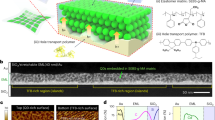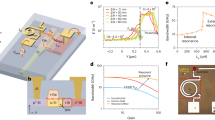Abstract
Conventional polarizers can be classified into three main modes of operation: sheet polarizer using anisotropic absorption media, prism polarizer by refraction and Brewster-angle polarizer by reflection1. These polarizing components are not easily integrated with photonic circuits. The in-line fibre polarizer, which relies on polarization-selective coupling between the evanescent field and birefringent crystal2 or metal3,4,5,6,7, is a promising alternative because of its compatibility with most fibre-optic systems. Here, we demonstrate the operation of a broadband fibre polarizer based on graphene, an ultrathin two-dimensional carbon material. The out-coupled light in the telecommunication band shows a strong s-polarization effect with an extinction ratio of 27 dB. Unlike polarizers made from thin metal film, a graphene polarizer can support transverse-electric-mode surface wave propagation due to its linear dispersion of Dirac electrons.
This is a preview of subscription content, access via your institution
Access options
Subscribe to this journal
Receive 12 print issues and online access
$209.00 per year
only $17.42 per issue
Buy this article
- Purchase on Springer Link
- Instant access to full article PDF
Prices may be subject to local taxes which are calculated during checkout




Similar content being viewed by others
References
Goldstein, D. Polarized Light 2nd edn (Marcel Dekker, 2003).
Bergh, R., Lefevre, H. & Shaw, H. Single-mode fiber-optic polarizer. Opt. Lett. 5, 479–481 (1980).
Feth, J. & Chang, C. Metal-clad fiber-optic cutoff polarizer. Opt. Lett. 11, 386–388 (1986).
Dyott, R. B., Bello, J. & Handerek, V. A. Indium-coated D-shaped-fiber polarizer. Opt. Lett. 12, 287–289 (1987).
Andreev, A. T., Kozlov, V., Kuznetsov, A. & Maksimov, A. Single-mode fiber polarizers for the spectral range 0.6–1.6 µm. Quantum Electron. 23, 617–619 (1993).
Tseng, S. M., Hsu, K. Y., Wei, H. S. & Chen, K. F. Analysis and experiment of thin metal-clad fiber polarizer with index overlay. IEEE Photon. Technol. Lett. 9, 628–630 (1997).
Li, G. Y. & Xu, A. S. Analysis of the TE-pass or TM-pass metal-clad polarizer with a resonant buffer layer. J. Lightwave Technol. 26, 1234–1241 (2008).
Neto, A. H. C., Guinea, F., Peres, N. M. R., Novoselov, K. S. & Geim, A. K. The electronic properties of graphene. Rev. Mod. Phys. 81, 109–162 (2009).
Bonaccorso, F., Sun, Z., Hasan, T. & Ferrari, A. C. Graphene photonics and optoelectronics. Nature Photon. 4, 611–622 (2010).
Loh, K. P., Bao, Q., Eda, G. & Chhowalla, M. Graphene oxide as a chemically tunable platform for optical applications. Nature Chem. 2, 1015–1024 (2010).
Nair, R. R. et al. Fine structure constant defines visual transparency of graphene. Science 320, 1308 (2008).
Mueller, T., Xia, F. N. A. & Avouris, P. Graphene photodetectors for high-speed optical communications. Nature Photon. 4, 297–301 (2010).
Bao, Q. et al. Atomic-layer graphene as a saturable absorber for ultrafast pulsed lasers. Adv. Funct. Mater. 19, 3077–3083 (2009).
Sun, Z. et al. Graphene mode-locked ultrafast laser. ACS Nano 4, 803–810 (2010).
Horing, N. J. M. Coupling of graphene and surface plasmons. Phys. Rev. B 80, 193401 (2009).
Hanson, G. W. Dyadic Green's functions and guided surface waves for a surface conductivity model of graphene. J. Appl. Phys. 103, 064302 (2008).
Mishchenko, E. et al. Guided plasmons in graphene pn junctions. Phys. Rev. Lett. 104, 156806 (2010).
Jablan, M., Buljan, H. & Soljacic, M. Plasmonics in graphene at infrared frequencies. Phys. Rev. B 80, 245435 (2009).
Mikhailov, S. & Ziegler, K. New electromagnetic mode in graphene. Phys. Rev. Lett. 99, 016803 (2007).
Stern, F. Polarizability of a two-dimensional electron gas. Phys. Rev. Lett. 18, 546–548 (1967).
Peres, N. M. R., Guinea, F. & Castro Neto, A. H. Electronic properties of disordered two-dimensional carbon. Phys. Rev. B 73, 125411 (2006).
Gusynin, V. P., Sharapov, S. G. & Carbotte, J. P. Unusual microwave response of Dirac quasiparticles in graphene. Phys. Rev. Lett. 96, 256802 (2006).
Maier, S. Plasmonics: Fundamentals and Applications 1st edn (Springer Verlag, 2007).
Johnstone, W., Stewart, G., Hart, T. & Culshaw, B. Surface-plasmon polaritions in thin metal-films and their role in fiber optic polarizing devices. J. Lightwave Technol. 8, 538–544 (1990).
Ohke, S., Umeda, T. & Cho, Y. TM-mode selective filter using leaky waveguide structure. Electron. Comm. Jap. II: Electron. 85, 9–15 (2002).
Rollke, K. H. & Sohler, W. Metal-clad waveguide as cutoff polarizer for integrated-optics. IEEE J. Quantum Electron. 13, 141–145 (1977).
Berini, P. Plasmon-polariton modes guided by a metal film of finite width. Opt. Lett. 24, 1011–1013 (1999).
Hanson, G. W. Quasi-transverse electromagnetic modes supported by a graphene parallel-plate waveguide. J. Appl. Phys. 104, 084314 (2008).
Okamoto, K. Fundamentals of Optical Waveguides (Academic Press, 2006).
Bae, S. et al. Roll-to-roll production of 30-inch graphene films for transparent electrodes. Nature Nanotech. 5, 574–578 (2010).
Acknowledgements
This work was supported by an NRF-CRP grant (‘Graphene Related Materials and Devices’, R-143-000-360-281). The authors thank R.J. Knize (United States Air Force Academy) for helpful discussions, B. Yan, T. Yu and Z.X. Shen (SPMS, NTU) for assistance with measurements at visible wavelengths, and X. Wu, L.M. Zhao and B. Lin (EEE, NTU) for assistance with measurements at near-infrared wavelengths. H.Z. acknowledges financial support from the Belgian Science Policy Office (BELSPO) Interuniversity Attraction Pole (IAP) programme (grant no. IAP-6/10) and experiment facility support from OPERA-photonique (Université libre de Bruxelles). The authors thank P. Kockaert, P. Emplit and M. Haelterman (Université libre de Bruxelles) for discussion and critical reading of this manuscript.
Author information
Authors and Affiliations
Contributions
K.P.L. supervised the project. K.P.L. and Q.B. planned the project. Q.B. and H.Z. conceived the original concept and performed most of the experiments. B.W. and Q.B. contributed to the numerical calculations. Z.N. contributed to measurements in the visible range. H.Z. and D.Y.T. contributed to the experiments in the NIR range. C.H.Y.X.L. and Y.W. contributed to graphene synthesis. K.P.L. and Q.B. analysed the data and co-wrote the paper. All authors discussed the results and commented on the manuscript.
Corresponding author
Ethics declarations
Competing interests
The authors declare no competing financial interests.
Supplementary information
Supplementary information
Supplementary information (PDF 1950 kb)
Rights and permissions
About this article
Cite this article
Bao, Q., Zhang, H., Wang, B. et al. Broadband graphene polarizer. Nature Photon 5, 411–415 (2011). https://doi.org/10.1038/nphoton.2011.102
Received:
Accepted:
Published:
Issue Date:
DOI: https://doi.org/10.1038/nphoton.2011.102
This article is cited by
-
High-performance multi-frequency optical switch based on tunable quadruple plasmon-induced transparency in monolayer patterned graphene metamaterial
Optical and Quantum Electronics (2024)
-
Graphene oxide for photonics, electronics and optoelectronics
Nature Reviews Chemistry (2023)
-
Tunable plasmonic terahertz filter based on a suspended monolayer graphene on a ring resonator
Optical and Quantum Electronics (2023)
-
Broadband terahertz metamaterial absorber with a tunable performance based on vanadium dioxide
Applied Physics A (2023)
-
An Analytical Model for Optimizing the Optical Absorption of Graphene-Based Two-Dimensional Multilayer Structure
Journal of Low Temperature Physics (2023)



